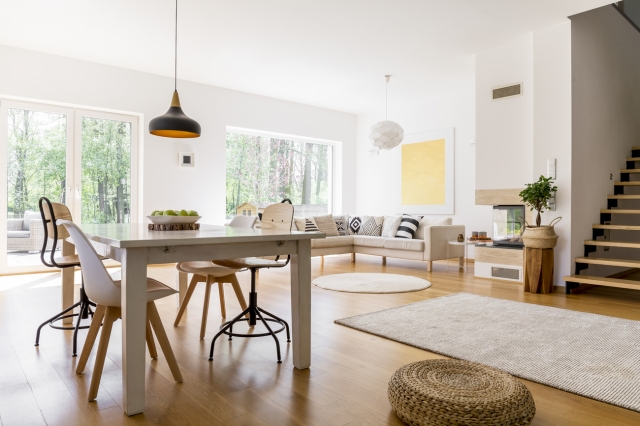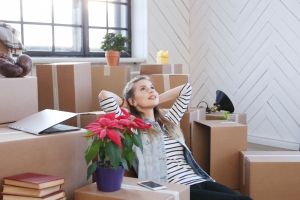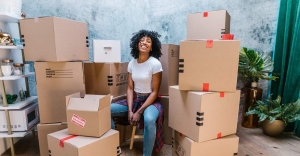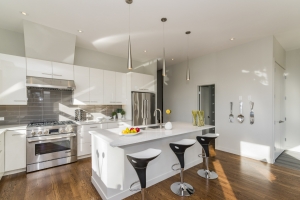Creating Flow From Room to Room
One of the biggest challenges in home design is creating a sense of cohesion without making everything feel overly matched or repetitive. Great design flows naturally from room to room, even if each space has its own vibe.
You can build flow by repeating subtle design elements—maybe it's a particular metal finish, a consistent wood tone, or a unifying accent color. These recurring features help create a sense of continuity without forcing every room into the same theme.
In open-concept homes, this becomes especially important. With fewer walls to divide rooms, visual flow helps define space without closing it off. Strategic use of area rugs, furniture placement, and lighting can subtly signal where one space ends and another begins.
The Impact of Natural Light
Lighting is one of the most underrated aspects of interior design. Natural light, in particular, can dramatically change how a space looks and feels. It makes colors pop, opens up the room, and creates an uplifting, healthy atmosphere.
Maximizing sunlight might mean using lighter curtains, installing larger windows, or incorporating glass doors. Mirrors are also a classic trick—they reflect and amplify light, especially when placed opposite a window.
In sun-soaked areas like Palm Beach, managing light is more about softening it than chasing it. Light-filtering shades, breezy linens, and well-placed plants can make rooms feel bright and cool at the same time. Many interior designers Palm Beach FL understand how to balance this coastal brightness with interior comfort.
Texture Brings a Room to Life
A common design mistake is focusing only on color and layout while forgetting about texture. Adding layers of texture—like a chunky knit throw, a sleek marble counter, woven baskets, or matte-finished furniture—makes a space feel more lived-in and interesting.
Texture creates visual weight and contrast. A room that's too flat can feel sterile, but mixing soft with hard, smooth with rough, or shiny with matte brings a tactile depth to your space.
It also helps define different zones within a room. For example, a plush area rug can anchor a seating area in a large living space, while a rough-hewn wood beam can add dimension to an otherwise polished kitchen.
Curating, Not Cluttering
There's a difference between decorating and cluttering. Good design isn't about filling every inch of a space with furniture or decor—it's about making intentional choices.
A few well-placed pieces can say more than a crowded gallery wall or a shelf overflowing with accessories. Leave breathing room. Let your statement pieces speak. Negative space can be just as powerful as the things you include.
This is where editing becomes important. Before adding something new, ask yourself: does it serve a purpose? Does it complement the space? Or is it just taking up room?
Curating your home is an ongoing process, and it evolves as your tastes and lifestyle change.
Indoor-Outdoor Living
In coastal areas like Palm Beach, design often blurs the line between indoors and out. Sliding glass doors, screened patios, and outdoor kitchens help bring the outside in and vice versa.
Interior design plays a big role here—coordinating colors, materials, and styles so that there's a seamless transition from your indoor living room to your outdoor lounge.
Weather-resistant materials, easy-clean fabrics, and durable finishes make outdoor spaces just as stylish and comfortable as their indoor counterparts. And adding plants, natural textures, and open sightlines helps reinforce that connection with nature, even from the sofa.
The Psychology of Color
Color isn't just visual—it's emotional. The tones you use in your home influence how you feel when you're in that space.
Soft blues and greens are calming and peaceful. Neutrals like taupe or greige create a clean, grounded energy. Bright tones like coral, citrus, or turquoise can energize a room and add personality.
Choosing the right palette starts with understanding the room's function. A bedroom might call for muted, relaxing tones, while a kitchen or creative space might benefit from bolder colors that energize the space.
Regional influences matter too. In beachy environments, many homeowners lean toward light, airy palettes that reflect the surrounding landscape—sand, sea, sky, and palm leaves.
Making a Small Space Feel Bigger
Not every room comes with sprawling square footage, but thoughtful design can make even a compact space feel expansive.
Light colors, streamlined furniture, and vertical storage are your best friends in small rooms. Mirrors, glass-top tables, and floating shelves can also keep things feeling open.
Avoid bulky furniture that dominates the space. Instead, opt for pieces with visible legs and open bases that maintain visual flow. Multifunctional furniture—like ottomans that double as storage or benches with hidden compartments—adds function without crowding the room.
In small homes or condos, designers often work smarter by focusing on flexibility and clean design lines to prevent the space from feeling cramped or chaotic.
Personal Style, Professional Vision
Interior design isn't just about creating a beautiful space—it's about reflecting the personality of the people who live there. The challenge is bringing that personal flair into a cohesive, functional design.
That's where collaboration with professionals can be helpful. A great designer won't just impose a style—they'll learn how you live, what you love, and what makes you feel at home. Then they'll help turn those ideas into reality with clarity and confidence.
Whether you're into classic elegance, modern minimalism, eclectic charm, or beachy vibes, working with experienced interior designers Palm Beach FL offers the opportunity to elevate your ideas into something polished, livable, and long-lasting.
Design is about more than appearance. It's about building a space that inspires you, works for you, and grows with you. When done right, it becomes something much more than decor—it becomes part of your lifestyle.






